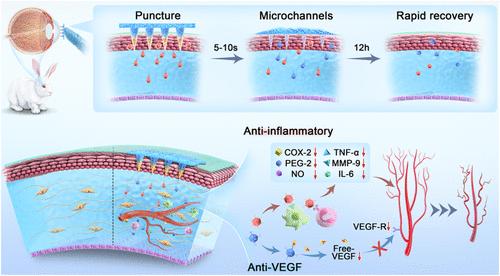溶解双分子层微针在角膜新生血管协同治疗中的高效基质内双重药物递送
IF 16
1区 材料科学
Q1 CHEMISTRY, MULTIDISCIPLINARY
引用次数: 0
摘要
角膜新生血管形成(CNV)是世界范围内视力损害和失明的主要原因之一。由于存在各种眼屏障(如泪液屏障、角膜上皮屏障等),抗血管生成药物的有效基质内递送是一个重大挑战。在这里,我们报道了一种快速溶解的双层微针(MN)贴片,将抗vegf抗体(Ava)与整合素靶向抗炎药(PF-Y-RGD)联合使用,实现了CNV的协同治疗。局部应用的MN贴片配备微型针尖,可可逆地穿透角膜上皮形成微通道,绕过泪液/上皮屏障,促进有效载荷药物运输到角膜间质层,显著提高药物的生物利用度。这种MN贴片具有双相药物释放行为,并且易于应用和微创,具有良好的眼耐受性。兔CNV模型显示,Ava与PF-Y-RGD在双层MN斑块中联合应用可显著抑制角膜新生血管的形成,减少角膜新生血管面积和各种细胞因子(如VEGF、TNF-α、IL-1β、MMP-9)的表达。作为一种有效的细胞内给药策略,本研究有望提供一种简单有效的治疗CNV的方法,这也可能为治疗各种眼部疾病提供途径。本文章由计算机程序翻译,如有差异,请以英文原文为准。

Highly Efficient Intrastromal Dual-Drug Delivery by a Dissolving Bilayer Microneedle for Synergistic Therapy against Corneal Neovascularization
Corneal neovascularization (CNV) is one of the major causes of vision impairment and blindness worldwide. Efficient intrastromal drug delivery of antiangiogenic agents is a significant challenge due to the presence of various ocular barriers (i.e., tear barrier, corneal epithelial barrier, etc.). Here, we report a rapidly dissolving bilayer microneedle (MN) patch, combining the anti-VEGF antibody (Ava) with an integrin-targeted anti-inflammatory drug (PF-Y-RGD), achieving synergistic therapy for CNV. Equipped with microscale needle tips, the topically applied MN patches reversibly pierce the corneal epithelium to generate microchannels, bypassing the tear/epithelial barrier and facilitating the transport of payload drugs into the stromal layer of the cornea, which significantly enhances drug bioavailability. Such MN patches exhibit biphasic drug release behavior and are also readily applicable and minimally invasive to impart good ocular tolerance. A rabbit model of CNV reveals that the combination of Ava with PF-Y-RGD in such bilayer MN patches robustly inhibits neovascularization and reduces neovascular areas and the expression of various cytokines (i.e., VEGF, TNF-α, IL-1β, MMP-9) in the cornea. As a strategy for efficient intrastromal drug delivery, this study promises an easy and effective way to treat CNV, which may also lead to approaches for curing various ocular disorders.
求助全文
通过发布文献求助,成功后即可免费获取论文全文。
去求助
来源期刊

ACS Nano
工程技术-材料科学:综合
CiteScore
26.00
自引率
4.10%
发文量
1627
审稿时长
1.7 months
期刊介绍:
ACS Nano, published monthly, serves as an international forum for comprehensive articles on nanoscience and nanotechnology research at the intersections of chemistry, biology, materials science, physics, and engineering. The journal fosters communication among scientists in these communities, facilitating collaboration, new research opportunities, and advancements through discoveries. ACS Nano covers synthesis, assembly, characterization, theory, and simulation of nanostructures, nanobiotechnology, nanofabrication, methods and tools for nanoscience and nanotechnology, and self- and directed-assembly. Alongside original research articles, it offers thorough reviews, perspectives on cutting-edge research, and discussions envisioning the future of nanoscience and nanotechnology.
 求助内容:
求助内容: 应助结果提醒方式:
应助结果提醒方式:


